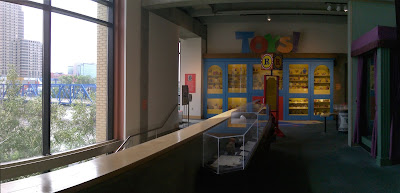 |
| Left is "Blue Bridge" over the Grand River; right museum |
The bright summer day pouring through the UV-protected picture windows of the Grand Rapids Public Museum in this photo prompted this question: how might it be possible to turn the lived-in downtown environment into something like a museum, complete with label text (e.g. GPS points to link an item's physical identifier to a paragraph of text, audio, and/or embedded links or imagery). That way the walls that separate inside from outside would disappear and the same expectations that visitors bring to poking around the permanent and temporary exhibitions could also accompany them outdoors on their way to and from school, work, shopping, or other occasion that brings the person into the cultural landscape. In fact this relationship between inside (glass cases, informative text, eye-catching artifacts, and thought-provoking references) and outside (hustle and bustle, preoccupied with schedules, and using minimal imagination or energy to engage with routine objects and subjects repeatedly passed by unexamined or reflected upon) could complement each other so that something of the museum visit attitudes apply to the everyday habits and repeated places and activities; but also the reverse, something of the "regular life" could also be applied in the museum setting to make the artifacts part of another time and another place, but still viewed now as "unremarkable, functional" parts of one's day, not as glass-encased specimens worthy of special scrutiny.
By "de-exoticizing" the exhibit elements (putting the artifacts back into the flow of normal life) and simultaneously "de-familiarizing" the world of consumer calculations, popular culture topics trending, and considerations about one's next meal or time commitment to honor, then the result is to make the museum more life-like to one's own time and place at the same time also making the places outside the walls of the museum a bit more interesting and museum-like; worth stopping to examine close up and learning the context of when and how the particular element in one's landscape of cultural meanings and background infrastructure came to be as it is now. In summary, with the help of prominent QR codes tagged to outdoor features big or small, curious gawkers and walkers could wander and wonder as they explore the city streets with a portable Internet device (phone or tablet or maybe a wristwatch or supercharge Internet glasses) and get to know their cultural landscape as an endless outdoor museum without walls, whether they be local residents or out-of-towners.
No comments:
Post a Comment